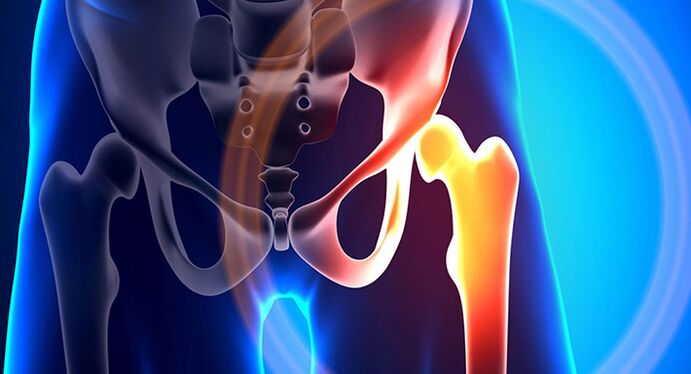
The hip joint is a large bony joint that connects the femur and pelvic bones, giving the limb the ability to bend, extend, and abduct. Pain in the hip joint is a symptom of many inflammatory, infectious, degenerative and other diseases. The causes of hip pain vary greatly, so a thorough diagnosis is essential.
Causes of hip pain
Pain in the hip joint varies: sharp and regular, constant and periodic. Most often, people over the age of 50 experience unpleasant sensations, although they can also occur in children. The causes of hip pain vary greatly. The most common is coxarthrosis, a degenerative disease with wear of the articular cartilage, in which the bones begin to move closer to each other and become deformed.
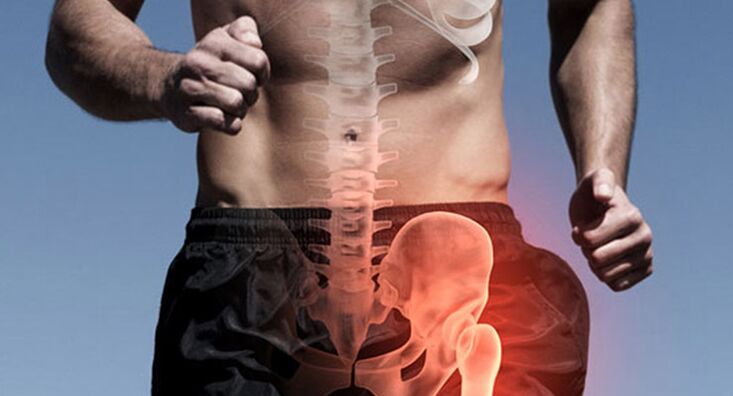
Pain in the right and left hip joint can have other causes:
- injuries - fractures, cracks, dislocations;
- damage to connective tissue and autoimmune diseases;
- osteochondropathy;
- skeletal development disorders;
- inflammation.
Sometimes the cause of rather severe pain is damage to other parts of the body (for example, the spine, sacrum, intestines). In this case, the treatment should solve the underlying problem, only then the hip joint will stop bothering the person.
Injuries as a cause of pain
Sharp pain involving only one hip joint may be a symptom of a traumatic injury. It is difficult for a healthy person to break a hip joint, but if you suffer from osteoporosis, this happens regularly. Basically, the diagnosis of "fracture of the neck of the femur" is given to women over the age of 60-65, in whom the cause of osteoporosis is menopause and disorders in the functioning of hormone-producing organs. If your femoral neck hurts after a fall or bruise, you should definitely carry out instrumental diagnostics!
A car accident can cause a pertrochanteric femur fracture. A sharp pain appears in the hip joint when the nerves are pinched.
Also, pain on the right or left appears against the background of:
- bruising of a bone joint due to a fall or direct blow;
- traumatic hip dislocation;
- congenital hip dislocation.
Injuries at birth and bone deformations during intrauterine development can cause congenital dislocation. Without treatment, the child's legs may have different lengths in the future and coxarthrosis will develop early.
Cause disease in adults and children
If symptoms recur or hip joint pain becomes chronic, they are often caused by systemic conditions or diseases of the hip joint itself.

In addition to coxarthrosis, the hip joint hurts for the following reasons:
- Purulent arthritis.It occurs due to infection of the thigh area with pyogenic bacteria. Any movement becomes impossible due to sharp pain, the affected area turns red and swells.
- Aseptic necrosis of the femoral head.The reason is poor circulation in the hip joint. The disease occurs mainly at a young age. Without treatment, there is a risk of muscle and tendon atrophy and the person becomes disabled.
- Ossifying myositis.It results from inflammation of the muscles and connective tissue, is associated with heredity or occurs after an injury.
- Ankylosing spondylitis.It causes inflammatory damage to the bone joint, resulting in limited mobility due to fusion of the joint cavity.
- Osteochondritis dissecans of the femur.The cartilage of the hip joint delaminates and tissue necrosis often develops.
- Bursitis and synovitis.In this case, severe pain in the hip joint area is associated with inflammation of the synovial bag or capsule.
Why do hip joints hurt on one or both sides and what other reasons are there?
The following diseases can be the cause:
- Reiter's syndrome;
- rheumatoid arthritis;
- spinal lesions with radicular syndrome;
- deformities of the feet, legs, knees;
- enthesopathy.
In pregnant women, the cause of pain in the right or left joint is often symphysitis - an inflammation of the pubic symphysis when the pubic bones diverge. In rare cases, tumors and gout of the hip joint can trigger symptoms in people.
Symptoms of pathologies
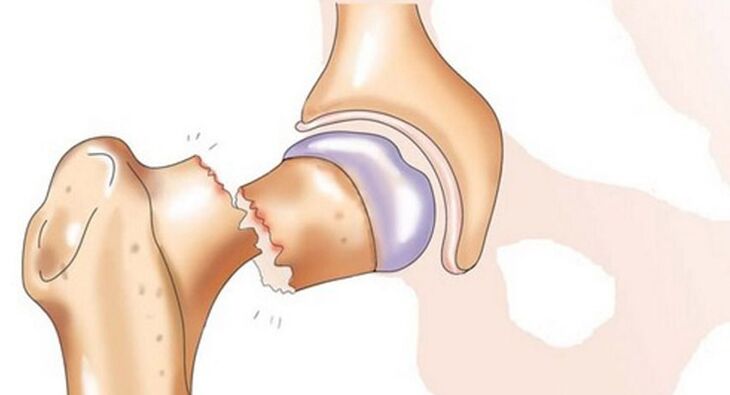
Signs of diseases, as well as treatment procedures, vary greatly. Pain in the hip joint after a serious injury is strong, sharp and localized in the thigh area. The surrounding tissues swell and lameness is observed. The latter, with a slight bruise, leaves quickly. If there is a dislocation, fracture, leg movements are limited or impossible.
For a hip fracture, the symptoms are:
- increased pain when moving;
- irradiation of sensations in the inner surface of the leg;
- swelling, bruising;
- lameness;
- joint click;
- muscle numbness.
When the bursa or synovial membrane is inflamed, the pain is accompanied by a burning sensation and intensifies when walking. With osteochondrosis, tingling and goosebumps appear in the hip joint. Coxarthrosis is accompanied by aching pain, which is strongest in the morning and disappears during the day. With rheumatoid arthritis, the hip joint hurts with low back pain, the temperature inside it rises and muscle stiffness appears.
Burning, nagging pain can be a sign of ankylosing spondylitis, and the sensations radiate to the pelvis, sacrum, and become stronger at night. The hip joint hurts in chronic inflammatory diseases - arthritis, gout (not exacerbation).
Disease diagnosis
Treatment for any of these symptoms should begin immediately after diagnosis by an orthopedist, surgeon, or trauma surgeon. Your doctor will be able to suggest damage to your left or right hip joint during the initial examination. During passive flexion and extension pain, burning sensation appear, movements are limited, lateral abduction is especially difficult.
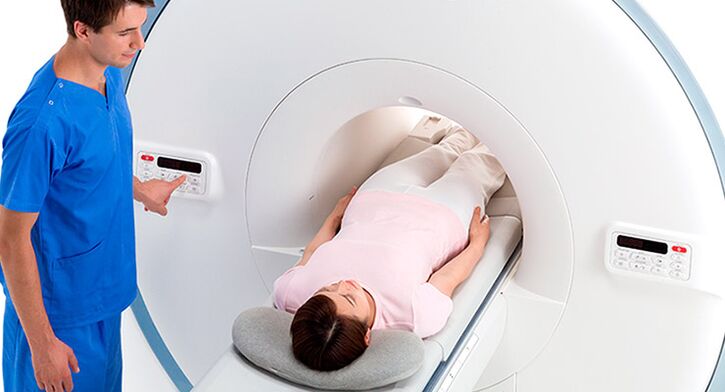
The hip joint is located quite deep, so instrumental examinations become the main diagnostic methods:
- TC;
- MRI;
- radiography.
In some cases, it is necessary to perform additional diagnostic measures. Therefore, in case of infectious and purulent processes, a study of synovial fluid is prescribed. If a malignancy is suspected, a biopsy is performed. If the vessels of the hip joint are affected, an ultrasound with Doppler ultrasound will be necessary. Before treatment of hip joint pain, a rheumatoid factor test should be performed to exclude the presence of rheumatism.
Treatment of hip pain due to injury and infection
In newborns, congenital dislocation of the hip joint is treated. To do this, they use the Freik pillow and spacers - special orthopedic devices that help keep the legs in the correct position. The duration of treatment can be 6-8 months; if it doesn't help, a surgical reduction of the bone will have to be performed.
For a hip fracture, surgical treatment is indicated, since conservative measures very often do not help. Pins, screws are installed or endoprostheses are performed. Only if there are contraindications are bandages applied to the leg from the waist to the heel. Unfortunately, in older age this rarely leads to fusion of the hip bone and the patient cannot walk or even sit normally.
What to do if the hip joint area hurts a lot due to infectious inflammation? In this case, treatment with antibiotics is performed. Medications are administered through injections, administered through an IV, or directly into the socket of the hip joint. Treatment also involves limiting the mobility of the leg to speed recovery. To relieve symptoms, analgesics and anesthetics are injected into the joint. For purulent arthritis, surgery is performed to remove abscesses and wash the joint cavity with antibiotics.
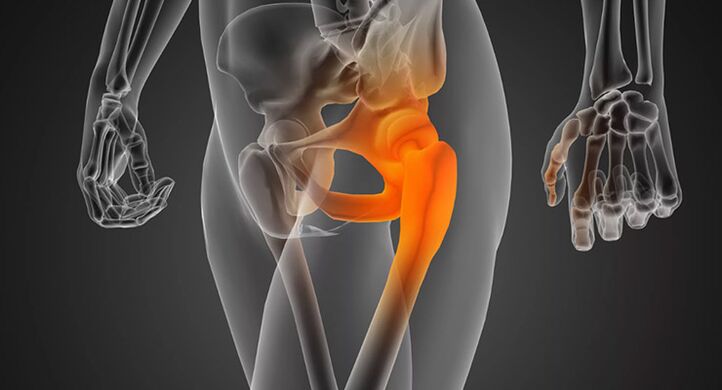
Pharmacological measures
The choice of drug treatment methods is made only by a doctor, depending on the type of disease. Aching pain is usually well relieved by taking analgesics, although the sensations often return quickly. If the leg hurts sharply and severely, it will be necessary to introduce blocks with anesthetics in the area of \u200b\u200bthe hip joint. Treatment of chronic hip pathologies should be carried out with regular courses of non-steroidal anti-inflammatory drugs - only they will eliminate recurrent symptoms, although they will not affect the course of the disease itself. For coxarthrosis, hormonal drugs are usually administered that relieve inflammation and pain for a long time.
Treatment of diseases of the hip joint can be carried out using the following means:
- Muscle relaxants.Used to reduce muscle spasm, which increases pain.
- Diuretics.Helps relieve severe swelling that affects soft tissue.
- Vitamin preparations.Improves nutrition of the hip joint, accelerates biochemical reactions.
- Chondroprotectors.They replenish chondroitin and glucosamine deficiency and help restore damaged cartilage.
If a child regularly has pain in the hip joint and the diagnosis of avascular necrosis is confirmed, the basis of treatment is taking and injections of vascular drugs. Medicines improve blood microcirculation, metabolism and help tissues regenerate.

Orthopedic devices and physical therapy
Treatment of diseases of the hip joint involves the use of orthopedic products. Most often they are used after injuries, when complete or partial immobilization is required for several weeks or even months. Therefore, a rigid fixation orthosis is used for fractures, which, unlike plaster, does not cause irritation and allergies.
If a person has to lie down for a long time, he definitely needs an anti-decubitus mattress. During rehabilitation after an injury, walkers, canes and crutches are used for support. With symphysitis, pregnant women are recommended to wear a pelvic corset with rigid ribs. It is equally important during treatment and for prevention to wear orthopedic shoes that lighten the load on the foot.
Physiotherapy is also indicated to improve the condition of the hip joint. This treatment eliminates symptoms, relieves pain and optimizes blood circulation. During the course of therapy, inflammation decreases, swelling disappears, and the process of tissue repair begins. Laser therapy has proven itself the best: laser beams heat tissues up to 10 cm thick, quickly relieve pain and relieve inflammation.
Other physiotherapeutic techniques used are:
- electrophoresis;
- darsonval;
- magnetotherapy;
- shock wave therapy;
- balneotherapy;
- microcurrents;
- turpentine baths.
It is also recommended to regularly use a needle applicator at home - it increases blood circulation and helps reduce pain. In the acute phase of the disease it is used for 5 minutes up to 5 times a day; in the chronic phase the time is increased to 20 minutes three times a day.

Traditional treatment for hip joint pain
Traditional medicine can also answer how to treat diseases of the hip joint. Unconventional treatment must be combined with conservative treatment, otherwise it will not bring the desired effect. External methods are less effective because the location of this bony joint is very deep. External measures can be applied through massage.
The treatment is carried out as follows:
- mix equal parts mint, hop cones, St. John's wort;
- pour 100 ml of Vaseline melted in a bain-marie onto a spoon;
- leave in a warm place for 2 days;
- Heat the mass again, filter;
- Apply by light rubbing with massage movements.
Baths can be used in the treatment of the hip joint: they quickly relieve pain. A decoction of mint and pine needles (50 g of raw material per liter of water) is poured into warm water, a bath is taken for 15 minutes, the procedures are repeated every other day, 10 sessions are performed. You should also take the following pain medications internally:
- Pour ½ cup of lilac flowers in 250 ml of vodka, leave for 10 days, drink a teaspoon three times a day for 14 days;
- mix a spoonful of birch buds and linden flowers, brew 300 ml of boiling water, drink 150 ml twice a day for a month;
- boil 1 kg of beef bones, pour the broth into portioned containers, eat 250 g of this "jelly" per day.
Other treatments
If the hip joint is affected, therapeutic exercises are indicated. The bone joint must move, so it will produce a greater volume of intra-articular fluid. As a result, the quality of nutrition and the rate of tissue restoration will increase. The set of exercises is selected individually; it is different for different diseases (based on the permissible load). At first the number of repetitions is small, after which it increases. You should not make sudden movements - they can provoke a new attack of pain.

In some cases, surgical treatment of the hip joint is necessary. It is indicated for injuries, advanced forms of coxarthrosis, rheumatoid arthritis, which cause serious bone deformations. They also intervene on a limb when abscesses (ulcers) appear in the joint cavity or in the soft tissues.
The most popular types of operations are:
- endoprosthesis;
- installation of pins;
- arthroscopy;
- osteotomy;
- osteosynthesis.
Prevention of joint diseases
Hip joint pain can be prevented if preventive measures are taken in time. It is necessary to avoid heavy loads on the femur and joint, protect yourself from impacts, falls and not lift heavy objects. Already in the initial phase it is necessary to treat any inflammatory diseases present in the body, as well as keeping vascular problems under control.
Gymnastics, physical therapy, yoga and swimming will help strengthen the hip joint. It is important to maintain a normal weight so as not to overload the femoral neck and the entire hip joint. To reduce body weight, use a diet that avoids fatty, sweet, floury foods, smoked meats and salty foods. It is also useful for the hip joint to wear preventive bandages, comfortable shoes and insoles. When the first unpleasant symptoms appear, you should immediately consult a doctor and receive timely treatment - this will help avoid surgery.














































